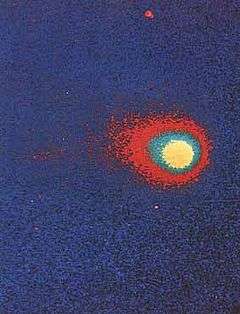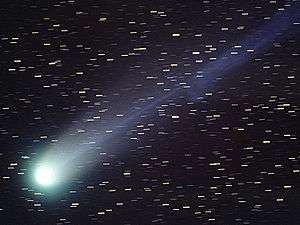Comet Kohoutek
|
A color photograph of the comet Kohoutek taken on 11 January 1974. | |
| Discovery | |
|---|---|
| Discovered by | Luboš Kohoutek |
| Discovery date | 7 March 1973 |
| Alternative designations | "Comet of the Century" |
| Orbital characteristics A | |
| Epoch | 24 December 1973 |
| Perihelion | 0.1424 AU |
| Eccentricity |
1.000008 (dropped below 1 in 1977) |
| Inclination | 14.3 |
| Last perihelion | 28 December 1973 |
Comet Kohoutek, formally designated C/1973 E1, 1973 XII, and 1973f, was first sighted on 7 March 1973 by Czech astronomer Luboš Kohoutek. It attained perihelion on 28 December that same year.
Comet Kohoutek is a long-period comet; its previous apparition was about 150,000 years ago, and its next apparition will be in about 75,000 years.[1] At its apparition in 1973 it had a hyperbolic trajectory (e > 1) due to gravitational perturbations from giant planets. Due to its path, scientists theorized that Kohoutek was an Oort-cloud object. As such, it was believed that this was the comet's first visit to the inner Solar System, which would result in a spectacular display of outgassing. Infrared and visual telescopic study have led many scientists to conclude, in retrospect, that Kohoutek is actually a Kuiper-belt object, which would account for its apparent rocky makeup and lack of outgassing.[2]
Before its close approach, Kohoutek was hyped by the media as the "comet of the century". However, Kohoutek's display was considered a let-down,[3] possibly due to partial disintegration when the comet closely approached the Sun prior to its Earth flyby. Since this was probably the comet's first visit to the inner Solar System, it would have still contained large amounts of frozen volatiles since its creation. Although it failed to brighten to levels expected, it was still a naked-eye object. Its greatest visual magnitude was −3, when it was at perihelion, 0.14 AU (21,000,000 km; 13,000,000 mi) from the Sun. Its orbital inclination is 14.3°. Its best viewing was in the night sky after perihelion, when it had dimmed to fourth magnitude. The comet also sported a tail up to 25° long, along with an anti-tail.
This comet was observed by the crews of Skylab 4 and Soyuz 13, thus becoming the first comet to be observed by a manned spacecraft, since Apollo 13's planned observations of the prominent naked-eye Comet Bennett were aborted by the moon-bound craft's oxygen-tank explosion.
C/1973 E1 should not be confused with the periodic comet 75D/Kohoutek, which can also be called "Comet Kohoutek". In addition, there are another two long-period comets, C/1969 O1-A (a.k.a. 1970 III, 1969b), and C/1973 D1 (a.k.a. 1973 VII, 1973e) also discovered by Luboš Kohoutek.
Social impact


Because Comet Kohoutek fell far short of expectations, its name became synonymous with spectacular duds. However, it was fairly bright as comets go and put on a respectable show in the evenings shortly after perihelion.
In 1973, David Berg, founder of the Children of God, predicted that Comet Kohoutek foretold a colossal doomsday event in the United States in January 1974.[4][5] Children of God members distributed Berg's message of doom across the country. The majority of U.S.-based members then fled in anticipation to existing communes, or formed new ones, around the world.
In popular culture
Comet Kohoutek inspired numerous musicians and other artists:
- In the comic strip Peanuts, Snoopy and Woodstock hide under a blanket from a "strange light" in the sky in a story arc spanning 29 December 1973 through 3 January 1974. Linus eventually identifies the light as Kohoutek.
- The jazz composer Sun Ra performed the Concert for the Comet Kohoutek in December 1973.
- The first single of German avant-garde music group Kraftwerk, released in December 1973, was called "Kohoutek-Kometenmelodie". On the album Autobahn, which appeared a few months later, the track title was shortened to "Kometenmelodie" (comet melody).
- The first album of Yahowha 13 from 1973 is called Kohoutek.
- Argent's 1974 album Nexus begins with three linked tracks inspired by Kohoutek: "The Coming of Kohoutek"; "Once Around the Sun"; and "Infinite Wanderer".
- The rock band Journey wrote and recorded the instrumental "Kohoutek", which appeared on their self-titled debut album Journey in 1975.
- Bill Carroll released an album in 1994 titled Kohoutek.
- The English techno group 808 State wrote and recorded the instrumental "Kohoutek", which appeared on their 1996 album Don Solaris.
- Since January 1974, Kohoutek Music and Arts festival has been a free spring event at Pitzer College honoring the comet.
- In the Mexican series El Chavo del Ocho, the characters are afraid of the fall of the comet.
- In The Simpsons episode 2F11, "Bart's Comet", Principal Skinner says he missed the chance to name a comet after himself once, but that he "got back" at Principal Kohoutek... "him and that little boy of his!"
- "In Celebration of the Comet - The Coming of Kahoutek" is the title of a popular and widely circulated bootleg album from the band Pink Floyd. Recorded on February 17, 1972, the concert featured a musical piece referred to by the band as "Eclipse Suite," (later re-dubbed "The Dark Side of the Moon" when the band eventually recorded it as an album in the studio later that year).
- Llee Heflin, a San Francisco writer and follower of Aleister Crowley, published what he claimed was a message from the comet in 1974 under the title Words from Kohoutek: The Message of the Serpent and the Dove.
- The Mexican poet Jaime Sabines used the Comet Kohoutek in his poem "Veremos"[6] as a way of making a reference to the immensity of time and space.
- Weather Report's 1974 Mysterious Traveller LP with cover painting of a comet over Madagascar was named after Kohoutek.[7]
- Burl Ives recorded a single called "The Tail of the Comet Kohoutek / A Very Fine Lady" (1974, 7 in., 45 rpm, MCA 40175).[8]
- Athens, Georgia rock band R.E.M. released the track "Kohoutek", in which the comet was a metaphor for a romantic relationship, on their album Fables of the Reconstruction in 1985. R.E.M. had previously announced their intentions to never play the song live again in 1997, but a live recording of the track (along with a large portion of their early years catalog) was recorded in 2007 and released later on the album Live at the Olympia in 2009.[9]
- A building at Epic Systems in Verona, Wisconsin is named after the comet and its discoverer.[10]
- The comet is frequently mentioned in the science fiction novel Lucifer's Hammer by Larry Niven and Jerry Pournelle.
See also
- Great comet, a comet bright enough to be noticed by casual observers
References
- ↑ calculated from original 1/a and future 1/a values. See IAUC 2588
- ↑ "Mystery of Kohoutek". The Star Online. 6 February 2006. Retrieved 27 January 2015.
- ↑ "New ‘Sun-Skirting’ Comet Could Provide Dazzling Display in 2013". Universe Today. Retrieved 2012-09-26.
- ↑ Berg, David Berg (1973-09-08). "The Christmas Monster!".
- ↑ Berg, David Berg (1973-11-12). "40 Days!—And Nineveh Shall Be Destroyed!".
- ↑ http://www.logospoetry.org/pls/wordtc/poesis.w6_start.doc?code=76232&lang=ES
- ↑ http://jazztimes.com/articles/19869-wayne-shorter-face-of-the-deep
- ↑ http://www.answers.com/topic/burl-ives
- ↑ 1985 IRS IRSC-5592/ 1985 CD MCA 5592
- ↑ http://host.madison.com/business/an-epic-expansion/article_bfbdcb36-b6d7-56a4-9832-8a44ab53eb31.html
External links
- Skylab's observations of Comet Kohoutek
- Comet of the Century TIME magazine article, 4 June 1973, on the expected "celestial display"
- Kohoutek: Comet of the Century TIME magazine article, 17 December 1973, on the comet, and comets in history
- Kohoutek, Comet Entry on the Internet Encyclopedia of Science
- C/1973 E1 at the JPL Small-Body Database
.jpg)

